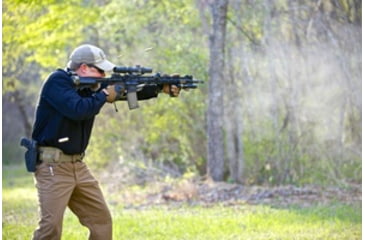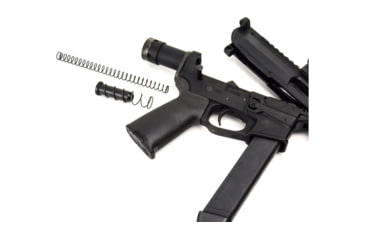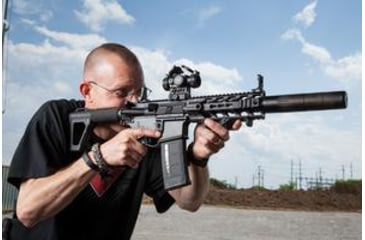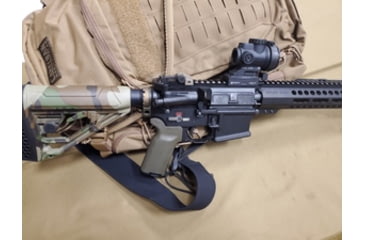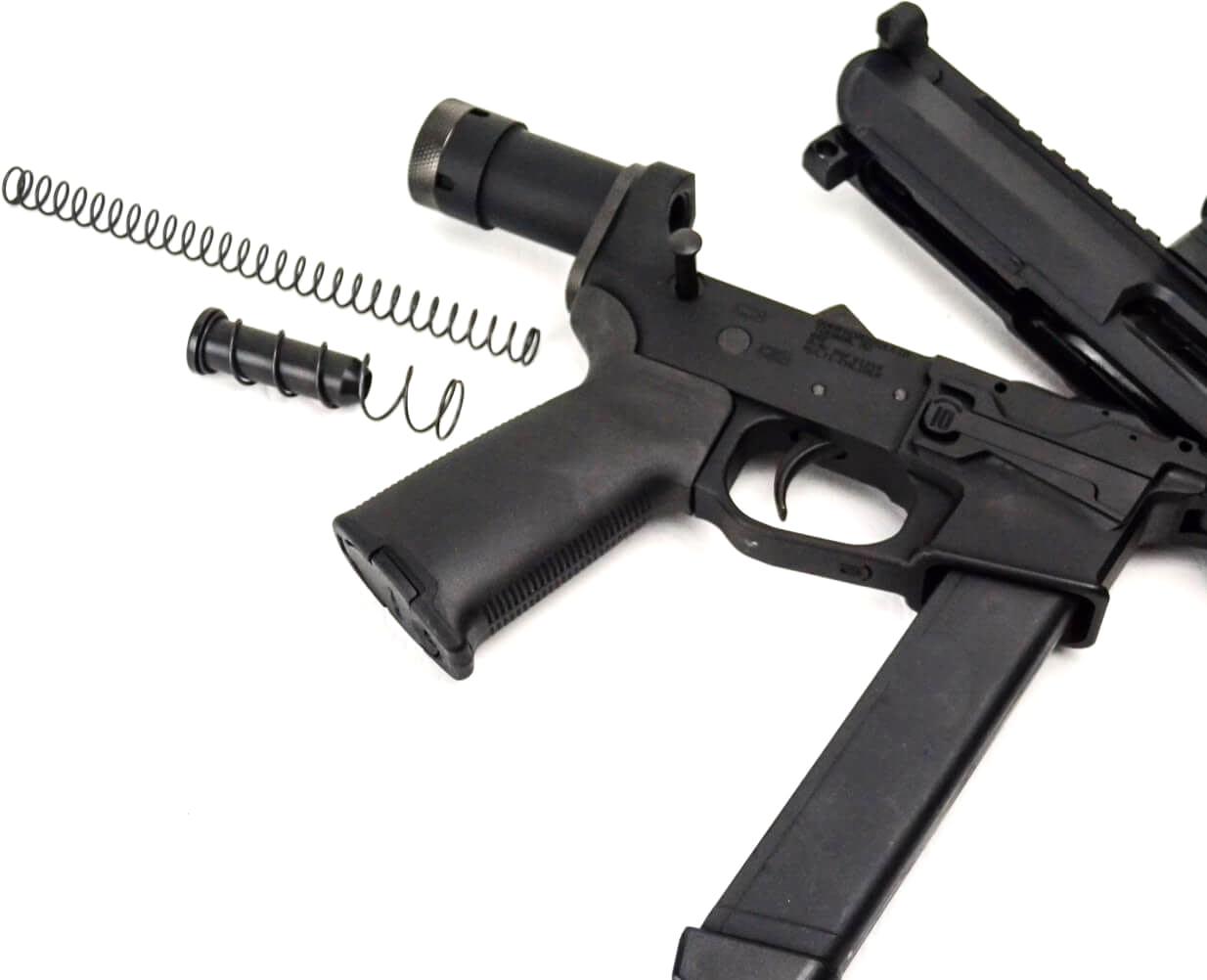Whether you are building an AR-platform rifle or pistol and want to tune it to a specific type of ammo or simply want to replace the internal gun parts in your current setup, there are many reasons to invest in a new buffer tube assembly. While this is a worthwhile upgrade, there is no straight answer to what weight buffer is needed in a particular setup, as lots of factors affect how the component affects your firearm’s function. However, we have assembled some basic guidelines that can help you determine which buffer weight is best for your firearm.![]()
What Is a Buffer? How Does It Work?
A buffer tube, also known as a receiver extension, of an AR15 is paired with a buffer spring and connects to the lower receiver. It acts as a mounting point for a stock or brace. The purpose of the buffer and spring is to slow the bolt carrier group and return it into battery. Essentially, when you fire the weapon, the recoil pushes the bolt carrier group back into the buffer and spring. This motion compresses and rebounds the buffer and spring, sending the bolt carrier group forward to cycle another round. Changing the buffer weight affects the speed and timing of the bolt carrier group.
What Are the Different Types of Buffer Tubes?
Fixed vs. Adjustable
Buffer tubes act as a mounting point for stocks and braces. You can use fixed or adjustable stocks depending on the buffer tube you select. Adjustable buffer tubes allow you to affix a stock to the tube and cycle through multiple positions, giving you different options for your length of pull. Fixed buffer tubes only have one single, fixed place.
Mil-Spec vs. Commercial
Carbine length buffer tubes are available in two styles: Mil-Spec and Commercial spec. Mil-Spec buffer tubes are designed to a certain standard that is universal across the U.S. military. So, any buffer tube labeled "Mil-Spec" is the same. They are 7.25" in length and have an outside diameter of 1.148". The threads on a Mil-Spec tube are more prominent in diameter than the rest of the tube (1.185"). Commercial Buffer Tubes look similar to Mil-Spec Buffer Tubes; still, they have different dimensions. The outside diameter of a Commercial spec tube is 1.168." It has a slanted back opposed to the straight back on a Mil-Spec tube. Any rifle or pistol that accepts AR15 buffer tubes can use either a Mil-Spec or Commercial-Spec buffer tube.
A5 Buffer Tube
You may have also heard of the A5 buffer tube. This tube is an adjustable, rifle-length buffer. Think of it as an extended carbine-length buffer tube that fits the same stocks but offers more adjustability. While carbine-length buffers allow for six-position adjustability of the stock, an A5 tube allows you to use the same stock with nine positions of adjustability. It also helps reduce the rifle’s recoil. If you decide to use an A5 buffer tube, use a buffer spring designed to fit in the A5 buffer tube for the best results and compatibility.
Weights & Lengths of AR15 Buffers
There are a few different weights and lengths when it comes to buffers.
- A standard Carbine buffer weighs 3 ounces.
- H buffers (Heavy Buffers) weigh 3.8 ounces.
- H2 buffers will vary slightly depending on the manufacturer but are typically 4.6 to 4.7 ounces.
- H3 buffers will also vary and are between 5.4 to 5.5 ounces.
Rifle buffers are longer than carbine buffers as they are designed for A2 buffer tubes (Rifle length buffer tubes) and weigh 5.1 to 5.3 ounces. Typical buffers have a static weight while newer designs utilize features such as hydraulics or magnets to affect performance. However, the exact way a buffer system behaves varies depending on the manufacturer.
What Are the Different Buffer Springs?
There are two main types of springs: carbine and rifle springs. A carbine spring is used with a carbine-length buffer tube, while a rifle spring is used with rifle length buffer tube. This applies to both AR15 and AR10 platforms. A carbine spring is typically between 10.0625 inches and 11.25 inches in length, as carbines tend to be shorter. For example, the Aero Precision Carbine Spring works in both AR-platform rifles and pistols, and is made of stainless steel for impressive durability. Longer springs offer more return power, which is why high-powered weapons use rifle springs that are typically between 11.75 inches and 13.5 inches in length. Springs can also vary in thickness, with thicker ones compressing and rebounding faster.
Selecting a Buffer
There are many factors that can affect which buffer to choose for your specific build, including barrel length, caliber, gas port size, gas system, and whether you plan to use a suppressor. The following guidelines are for an AR 15 chambered in 5.56/.223 to help you easily choose the correct buffer for your setup.
| Barrel Length | Gas System | Buffer Weight |
| 18" and Above | Mid-Rifle Length | Standard/H Buffer |
| 14.5" - 16" | Carbine-Mid Length | H/H2 Buffer (H2 if Suppressed) |
| 10.5" - 11.5" | Carbine Length | H2/H3 (H3 if Suppressed) |
| 10" and Under | Carbine-Pistol Length | H2/H3 |
If you have or plan to build an AR-platform rifle in 7.62x39, .300 Blackout, .458 SOCOM, .450 Bushmaster, or another larger caliber, the H3 buffer is the standard choice to reduce recoil impulse and provide reliable functionality.
Pistol Buffers
Any AR that uses a pistol cartridge requires its own specific buffer. Due to the lack of a gas system and heavier bolt carrier group found on pistol caliber carbines, they require much heavier buffers that are anywhere between 5.0 to 8.5 ounces.
Summary
Selecting the correct buffer weight for your setup depends on multiple different factors. Often, it can become a trial-and-error process to find the correct weight that allows for proper functionality. You may also find that a certain buffer functions better with different types of ammunition. For example, a lighter buffer often provides better results if you use subsonic ammo and a suppressor, as the recoil is lessened. On the other hand, if you are using high-velocity rounds, a heavier buffer system helps negate the recoil.
Here at OpticsPlanet, we have a wide variety of buffer systems available. From individual buffers and springs to complete buffer kits, we have everything you need to customize your firearm. We also have plenty of .223 Remington & 5.56 NATO ammo in stock, as well as rifle barrels, rifle triggers, and muzzle devices. Check out our selection today for help building your dream weapon!
